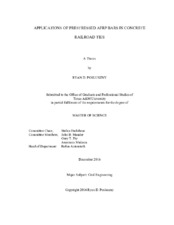| dc.description.abstract | Since the 1970’s concrete railroad ties have become more and more prominent in the railroad industry. Their improved durability and increased safety over traditional timber ties has paved the way for new and more efficient concrete ties to be developed. Prestressing with steel strands was a key design aspect in providing the strength the ties needed to overcome the tonnage seen in heavy haul lines spread across the United States and the world. A major flaw seen with these concrete ties is deterioration due to environment or fatigue loading under the connected rail. This deterioration can lead to a change in gauge of the track structure which can then cause derailment of trains. A second issue found in concrete ties that was not found in timber is the electrical conductivity. Timber is a highly insulating material while concrete possesses insulating and conductive properties based on the amount of moisture present. This is an issue because track structures use the steel rails to carry electrical signals to detect the presence of a train within a signaled block. During construction, the steel strands may come into contact with the embedded steel shoulders on both sides of the tie, therefore creating a direct circuit that needs to be insulated from the steel rails.
Aramid fiber-reinforced polymer bars have shown promise, as an electrical non-conductive material, to fix the problem of false signaling due to electrical shorts. AFRP is a composite material made of Kevlar fibers bound in a polymer resin. This material has a tensile strength of approximately 200 ksi and has been investigated for use as a replacement for steel in such structures as concrete bridge girders and decks. The objective of this research is to design and test new concrete railroad ties utilizing AFRP as the prestressing material. Four of these ties were constructed and tested for strength following the guidelines provided by the American Railroad Engineering and Maintenance-of-way Association (AREMA). Bending tests at the rail seat section and center section of the tie were performed to prove strength adequacy, and electrical resistivity tests were performed to prove insulation from the current in the rails. The AFRP ties showed to have over twice the electrical resistance of their steel counterparts with 2.42 MΩ of resistance compared to 1.11 MΩ. The strength comparison proved inconclusive, for although the ties did not fail, they did not meet AREMA cracking requirements for strength. A major factor that was seen was in the method of testing AREMA provides, through improved testing procedures, AFRP shows to be very promising as a full replacement of steel as prestressing reinforcement for concrete railroad ties. | en |


